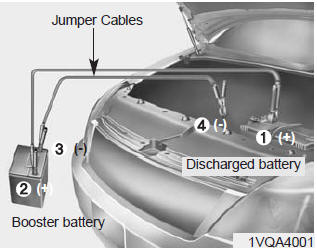 Kia Rio: Emergency starting
Kia Rio: Emergency starting

Connect cables in numerical order and disconnect in reverse order.
Jump starting
Jump starting can be dangerous if done incorrectly. Therefore, to avoid harm to yourself or damage to your vehicle or battery, follow these jump starting procedures. If in doubt, we strongly recommend that you have a competent technician or towing service jump start your vehicle.
CAUTION - 12 volt battery
Use only a 12-volt jumper system. You can damage a 12-volt starting motor, ignition system, and other electrical parts beyond repair by use of a 24- volt power supply (either two 12-volt batteries in series or a 24-volt motor generator set).
WARNING - Battery
Never attempt to check the electrolyte level of the battery as this may cause the battery to rupture or explode.
WARNING - Frozen batteries
Do not attempt to jump start the vehicle if the discharged battery is frozen or if the electrolyte level is low as the battery may rupture or explode.
WARNING - Battery
Keep all flames or sparks away from the battery. The battery produces hydrogen gas which will explode if exposed to flame or sparks.
WARNING - Sulfuric acid risk
When jump starting your vehicle be careful not to get acid on yourself, your clothing or on the vehicle. Automobile batteries contain sulfuric acid. This is poisonous and highly corrosive.
Jump starting procedure
Absorbent Glass Matt (AGM) batteries are maintenance-free and should only be serviced by an authorized Kia dealer. For charging your AGM battery, use only fully automatic battery chargers that are specially developed for AGM batteries.
When replacing the AGM battery, use only the Kia genuine battery for the ISG system.
✽ NOTICE
If the AGM battery is reconnected or replaced, ISG function will not operate immediately. If you want to use the ISG function, the battery sensor needs to be calibrated for approximately 4 hours with the ignition off and then, turn the engine on and off 2 or 3 times.
CAUTION - AGM battery cap
Do not open or remove the cap on top of the battery. This may cause the leak of dangerous internal electrolytes.
1.Make sure the booster battery is 12-volt and that its negative terminal is grounded.
2.If the booster battery is in another vehicle, do not allow the vehicles to touch.
3.Turn off all unnecessary electrical loads.
4.Connect the jumper cables in the exact sequence shown in the illustration.
First connect one end of a jumper cable to the positive terminal of the discharged battery (1), then connect the other end to the positive terminal on the booster battery (2).
Proceed to connect one end of the other jumper cable to the negative terminal of the booster battery (3), then the other end to a solid, stationary, metallic point (for example, the engine lifting bracket) away from the battery (4). Do not connect it to or near any part that moves when the engine is cranked.
Do not allow the jumper cables to contact anything except the correct battery terminals or the correct ground. Do not lean over the battery when making connections
CAUTION - Battery cables
Do not connect the jumper cable from the negative terminal of the booster battery to the negative terminal of the discharged battery. This can cause the discharged battery to overheat and crack, releasing battery acid.
5.Start the engine of the vehicle with the booster battery and let it run at 2,000 rpm, then start the engine of the vehicle with the discharged battery.
If the cause of your battery discharging is not apparent, you should have your vehicle checked by an authorized Kia dealer.
Push-starting
Your manual transaxle-equipped vehicle should not be push-started because it might damage the emission control system.
Vehicles equipped with automatic transaxle cannot be push-started. Follow the directions in this section for jump-starting.
WARNING - Tow starting vehicle
Never tow a vehicle to start it because the sudden surge forward when the engine starts could cause a collision with the tow vehicle.
 Emergency while driving
Emergency while driving
If the engine stalls at a crossroad or crossing
If the engine stalls at a crossroad or crossing, set the shift lever in the N
(Neutral) position and then push the vehicle to a safe place.
If you h ...
 Engine overheat
Engine overheat
If your temperature gauge indicates overheating, you will experience a loss of
power, or hear loud pinging or knocking, the engine is probably too hot. If this
happens, you should:
1.Pull off the ...
See also:
Rear Washer Motor Inspection
1.
With the washer motor connected to the reservoir tank, fill the
reservoir tank with water.
2.
Remove the front bumper cover. (Refer to t ...
Inspection
[Rotor]
1.
Check that there is continuity between the slip rings (C).
2.
Check that there is no continuity between the slip ...
Hood switch Removal
1.
After loosening the mounting bolts and connector, then remove
the hood switch (A).
...
